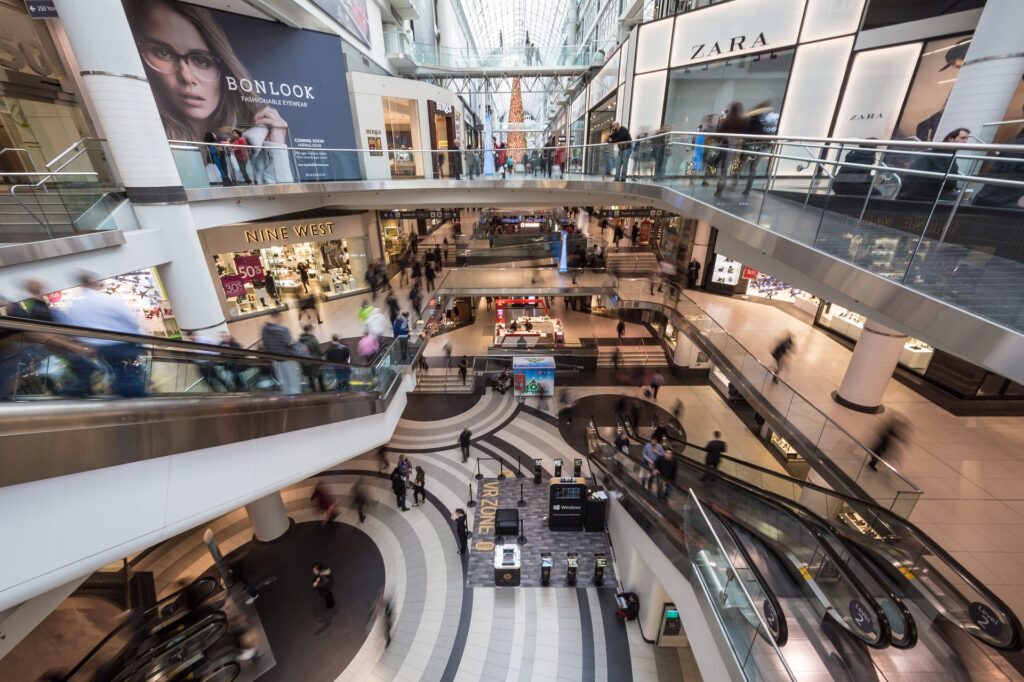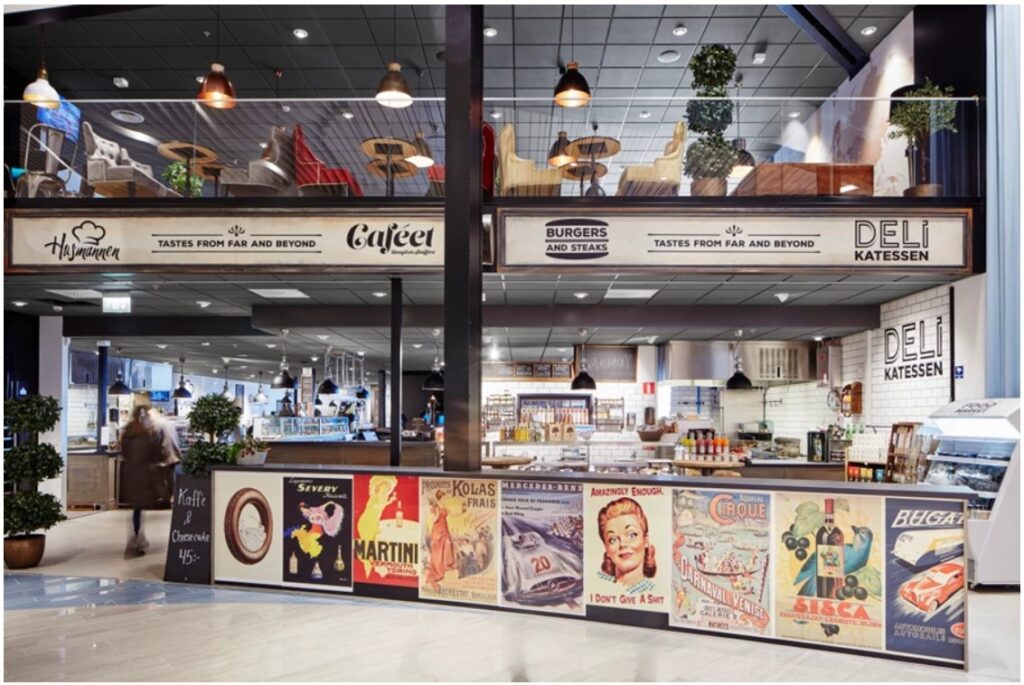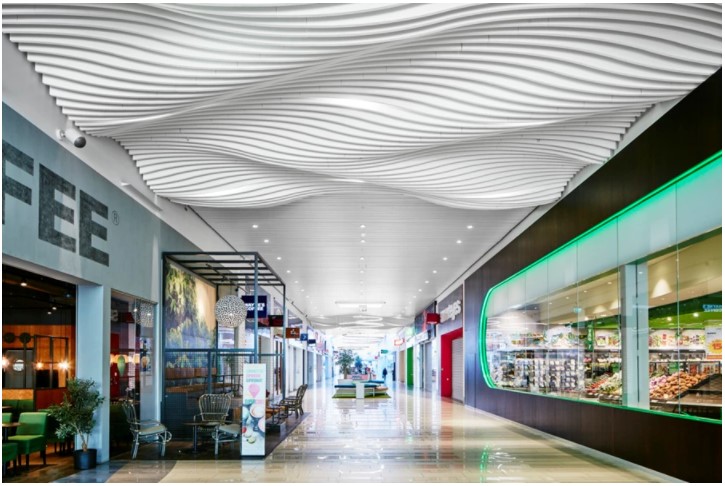
Shopping centers are frequented not only by people with commercial intentions, but also by visitors with social and leisure purposes. The latter implies that there is often a large circulation in the different spaces of the shopping centre, which are generally large, open-plan, and with high ceilings. In addition to that, there is also often a large food court where a large number of people gather together, and which in turn can generate high noise levels that can potentially create uncomfortable and even harmful sound environments for the health of end-users.
Modifying people’s behaviour with noise
The “acoustic space” of a shopping centre is orchestrated by its management, in order to promote a stimulating and pleasant sense of the place that helps fulfilling its economic, political and social purposes: to make people spend time and money within the establishment. With noise (unwanted) and sound (desired) the behaviour of the visitors can be modified to some extent. In the study presented in[1], for example, some of the participants confessed that the music played in a particular store cheered them so much that they were concerned about behaving in an inappropriate way (dancing or singing) inside the store. Those who had negative responses, on the contrary, were consumers who felt that the music in certain stores was “discriminatory”, in the sense that it seemed to be directed at particular gender or age groups that excluded them. Volume also proved to be another major source of concern; the greater the volume, the greater the “imposition” that buyers felt. Some avoided “noisy” retail spaces and others reported having bought faster than they would have liked.
In the experiments presented in[2], low-volume music and noise were shown to increase healthy food sales due to induced relaxation, while high noise levels tended to increase levels of excitement and agitation, which in turn resulted in unhealthy food choices.

Other studies have shown that increased noise levels can increase beverage consumption, as the “arousal” produced encourages one to drink faster and ask for more[3][4]. These noise levels (and their type) can even alter taste and smell[5][6][7].
Harmful noise levels
The health effects of noise can be auditory (levels above 85 dBA increase the risk of permanent hearing loss[8]) or non-auditory, such as sleep disorders or cardiovascular disease. These effects can be controlled and counteracted with an adequate acoustic design[9][10].
In [11], four Portuguese shopping centers were analysed. To that end, reverberation time (RT), background noise and RASTI1 (measure of intelligibility) were measured at various occupancy conditions, and both in the restaurant area and at the lowest floor of the shopping center. It was shown that the noise levels depended strongly on the height of the ceilings, the number of floors in the establishment, the type of galleries and corridors, as well as the acoustic absorption coefficients of the coatings. The measured RT values ranged from 1.7 to 3.2 seconds, and the noise level from 67 dB to 70 dB. The RASTI values (measured “without occupancy”) were between 0.41 and 0.51 (estimated “with occupancy”, the results would have probably been worse). Finally, in this study they suggested target values of different acoustic parameters for shopping centres: RT=1.1-1.3 seconds (average of 500, 1000 and 2000 Hz), LAeq≤55 dB and RASTI≥0.45.

The case study presented in[12] investigated three floors of the Sheffield’s Meadowhall, one of the largest indoor shopping centers in the UK. In addition to “objective” acoustic measurements (equivalent noise level and reverberation time), acoustic comfort surveys were also conducted amid customers and staff. Acoustic measurements yielded high reverberation time and noise levels (the latter fluctuating considerably depending on the time of the day and day of the week). Subjective evaluations proved to depend, in addition to objective acoustic indices, on other factors such as the length of stay in the shopping centre, the activities being carried out, the type of sound and even the acoustic comfort of the respondent’s homes.
In the shopping center studied in[13], acoustic measurements were carried out during a whole week. Particularly, reverberation time (RT), without occupation, as well as equivalent sound pressure levels (LAeq) with occupation at different times of the day, were measured. The measurements were made at different places, chosen according to their use: shopping area, entrance halls, food court and playground area. The acoustic comfort of the workers was also subjectively evaluated through a questionnaire. The average RT values that were measured ranged from 0.9 seconds (in the restaurant area) to 1.4 seconds for the main entrance. The LAeq, in turn, reached a minimum of 58 dB in the shopping area during the early morning, and a maximum of 83 dB in the playground area during the afternoon/evening.
The results of the questionnaire showed that headaches and difficulties in communicating with others are the most common noise-induced problems among workers, occurring in 47.1% and 38.2% of respondents respectively.
Higher values of noise levels were reported in[14], where the sound pressure reached values of 75 dBA and 81 dBA for two different restoration areas. According to the study, this was due to the activation of the Lombard effect, which is the involuntary tendency to increase vocal effort when speaking in a noisy place to improve the audibility of the voice, which consequently increases the noise level of the voice.

Good acoustics as an extra source of income
In a study presented by the author of this article at Internoise 2019[15], it was shown that in addition to acoustic comfort, good room acoustics can potentially also increase the revenue of a restaurant, which is an important thing to bare in mind when designing food courts of shopping centers. This conclusion was reached after evaluating the effect of an acoustic refurbishment (through the installation of Ecophon products in the ceiling) in three ways: (i) questionnaires (ii) measurements of different acoustic objective parameters (iii) a financial analysis.
In the study (a more thorough summary can be found here), in addition to the marked improvement of all objective acoustic parameters after the intervention (equivalent sound pressure levels, reverberation time, speech clarity and sound strength) due to the introduction of Class A absorbing material, the questionnaires revealed that the clients’ satisfaction with the noise levels was improved as well the easiness to communicate with the the other guests. Consequently, opinions in online platforms also improved (specifically, in “El Tenedor” -Spanish The Fork– they rose from 8 to 8.4).
Finally, the turnover in the 6 months after the renewal with respect to the same months of the previous year increased by 11% (without changing the price list), with a ROI (on the profit, not on invoicing) of 4 months. It it worth mentioning that the activity of the restaurant was not interrupted at any time during the installation of the material.
Acoustic design of a shopping centres
The acoustic design of shopping centers is a complex subject, since it is an interdisciplinary field (physics, architecture, psychology, hygiene, etc.) where many factors come into play (economic, scientific, individual differences, etc.) and participants (owners, clients, institutions, etc.). Furthermore, speech is an individual, dynamic, and quite unpredictable sound source that is not easy to handle, as different people are affected in different ways. Finally, the nature of these enclosures are usually large volumes, and very different activities that are carried out in them (children’s games, restaurants, shopping…) and where there are also other sources of noise (along with voice) such as HVAC equipments, pumps, etc.
All of the above makes it difficult to generalise acoustic design for this type of spaces, making it necessary to study project by project. The acoustic quality of a shopping center depends on many factors: the number of floors, the height, the morphology of the space, the volume, the configuration of the galleries and corridors that connect the different spaces and through which the noise easily propagates, sound sources, etc. Also, the materials used and their surface coatings (often sound reflective materials like ceramic, marble or glass) help noise levels to escalate. To reduce reverberation in the space, improve intelligibility, reduce noise propagation and ultimately increase comfort, high absorbing acoustic conditioning solutions must be used both on ceilings and on walls.

Only through proper acoustic design we can ensure that the noise levels do not exceed the recommended limits, thus reducing the negative effects of noise exposure on health (auditory and non-auditory). As the author points out in [16], the solution to this problem lies in the possible economic benefits for the owner in the improvement of acoustic conditions, and not only in legislative measures.
By Juan Negreira & Morten Roar Berg
Sources:
[1] You Stop the Music: How Sounds in Retail Stores Divide Shoppers:
https://www.smartcompany.com.au/industries/retail/you-cant-stop-the-music-how-sounds-in-retail-stores-divide-shoppers/
[2] D. Biswas, K. Lund, C. Szocs: Sounds: “Sounds like a healthy retail atmospheric strategy: Effects of ambient music and background noise on food sales, Journal of the Academy of Marketing Science, 47, pp 37–55, 2019.
https://link.springer.com/article/10.1007/s11747-018-0583-8
[3] N. Guéguen, H. Le Guellec, C. Jacob: Sound level of background music and alcohol consumption: An empirical evaluation. Perceptual&Motor Skills, 99, pp.34-38, 2004.
https://journals.sagepub.com/doi/abs/10.2466/pms.99.1.34-38?journalCode=pmsb
[4] N. Guéguen, N. C. Jacob, H. Le Guellec, T. Morineau, M. Lourel: Sound Level of Environmental Music and Drinking Behaviour: A Field Experiment with Beer Drinkers. Clinical and Experimental Research, 32, pp.1795-1798, 2008.
https://onlinelibrary.wiley.com/doi/abs/10.1111/j.1530-0277.2008.00764.x
[5] L.D. Stafford, M. Fernandes, E. Agobiani: Effects of noise and distraction on alcohol perception, Food Quality & Preference, 24, pp.218-224 2012.
https://www.sciencedirect.com/science/article/pii/S0950329311002345?via%3Dihub
[6] A.T. Woods, E. Poliakoff, D.M. Lloyd, J. Kuenzel, R. Hodson, H. Gonda, J. Batchelor, G.B. Dijksterhuis, A. Thomas: Effect of background noise on food perception. Food Quality and Preference, 22, pp. 43-47, 2011.
https://www.researchgate.net/publication/233831746_Effect_of_background_noise_on_food_perception
[7] A. Fiegel, J.F. Meullenet, R.J. Harrington, R. Humble, H.S. Seo: Background music genre can modulate flavor pleasantness and overall impression of food stimuli, Appetite, 76, pp. 144-152, 2014.
https://www.sciencedirect.com/science/article/abs/pii/S0195666314000890
[8] The United State, Department of Labor, Occupational Safety and Health Administration. Code of Federal Regulations, Title 29, Part 1910, Section 1910.95—Occupational Noise Exposure. 1 July 2011.
https://www.govinfo.gov/content/pkg/CFR-2011-title29-vol5/pdf/CFR-2011-title29-vol5-sec1910-95.pdf
[9] M. Basner, W. Babisch, A. Davis, M. Brink, C. Clark, S. Janssen, S. Stansfeld: Auditory and non-auditory effects of noise on health. Lancet, 383, pp.1325–1332, 2004.
https://www.ncbi.nlm.nih.gov/pmc/articles/PMC3988259/
[10] W. Passchier-Vermeer, W.F. Passchier: Noise Exposure and Public Health. Environ. Health Perspect, pp.108, 123, 2000.
[11] A. Carvalho, C. Pereira: Sound and Noise in Shopping Malls, Proceedings of Noise-Con 2016, Providence (USA).
https://paginas.fe.up.pt/~carvalho/nc16.pdf
[12] B. Chen, J. Kang: Acoustic Comfort in Shopping Mall Atrium Spaces – A Case Study in Sheffield Meadowhall, Architectural Science Review, 47(2), pp 107-114, 2014.
https://www.tandfonline.com/doi/abs/10.1080/00038628.2004.9697033
[13] N. Alnuman, Z. Altaweel: Investigation of the Acoustical Environment in A Shopping Mall and Its Correlation to the Acoustic Comfort of the Workers, Applied Sciences, 10(3), pp 1170, 2020.
https://www.mdpi.com/2076-3417/10/3/1170
[14] R. Pimentel, L. Soares-Esmeraldo, M. Nunes-Navarro: Sound Pressure Levels in Food Courts or Shopping Centers, Noise&Vibration Worldwide, 39(5), pp 26-30, 2008.
https://journals.sagepub.com/doi/abs/10.1260/095745608784645606?journalCode=nvwa
[15] J. Negreira, C. Svensson, N. Oseland, R. Canto: Good acoustics as an extra source of income in restaurants – A case study, Internoise 2019, Madrid.
https://www.acousticbulletin.com/good-acoustics-as-an-extra-source-of-income-in-restaurants
[16] J. Hopkins: Orchestrating an Indoor City: Ambient Noise Inside a Mega-Mall. Environmental Behaviour, 26, pp.785-812, 1994.


